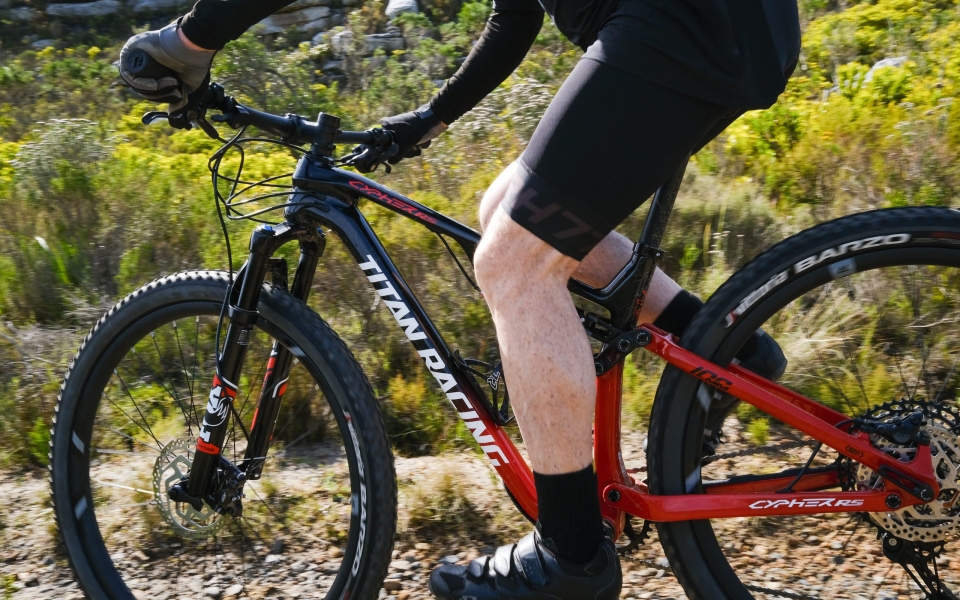TESTED: Titan Racing Cypher RS Carbon Elite
THE SAME SPEED FOR LESS
The Cypher platform was launched a few years ago, and it’s been a resounding success for Titan Racing. For the first time, local riders had a homegrown alternative to the slew of international bikes that tend to dominate this category.
Cliff Beckett, previously of Pyga, was the man charged with bringing the bike to life; and he’s done a great job. There’s an echo of Cannondale Scalpel in there, and of Specialized Epic; but it’s also an entirely unique creation that rides, well… like a Cypher.
It’s important to note that the Cypher comes in two iterations – the RS is a pure XC bike with 100mm of travel front and rear, whereas the ‘standard’ Cypher is more of an all-rounder. It uses the same frame, but rear travel is pushed to 120mm and it comes with a 120mm fork. It also gets a dropper post.
We asked Titan Racing to recommend their most popular model across the range, and they sent us the RS Carbon Elite. For the price, the spec is excellent. You get a lightweight carbon frame; a decent Fox Rhythm 32 fork (more on that later); lots of Shimano XT (derailleur, shifter, brakes); and in-house carbon wheels, seat post and cockpit components.
For the price, the spec is excellent
Titan Racing recently made a subtle branding upgrade, and the new Cyphers will carry a sharper logo and a few other small tweaks – none of which detracts from this ‘older’ model. The colour might be polarising, but we think it’s hot. It harks back to a time before bikes came in colours named after distant galaxies, when red-and-black meant ‘fast’.
And there’s lots of space in the front triangle for two bottles, a lockout lever that firms up the fork and shock simultaneously, and a flip chip that changes the frame geometry quite radically.
What’s it like to ride?
For a bike with ‘only’ 100mm of travel and a relatively steep head-tube angle compared to its competitors, the Cypher RS is a beast. Riding my local trails in Tokai, Cape Town, I never felt I was under-biked. I churned my way up rocky climbs and flew down singletrack with a big smile on my face.
The geometry does take some getting used to. That steep-ish head angle means that the steering is precise – which is what you want from an XC bike – but you do have to think twice before slamming into a bigger obstacle like you would on the Trek Top Fuel, for example, which has longer-travel suspension and more forgiving angles.
To make it a bit more ‘trail-friendly’, I tried changing the flip chip in the frame. In ‘high’ mode, the head angle is 69°, which changes to 68.5° in ‘low’; but the main difference is the BB drop, which goes from 37mm to 42mm, lowering the BB height by 5mm. In ‘low’, the BB height is 327mm – the lowest on test.
I noticed the difference immediately. Being closer to the ground definitely made me feel more planted on the trail. I was more confident going into drops and rock gardens, and I felt more in control on sketchy singletrack climbs. The only negative was the increased frequency of pedal strikes. I hit more rocks with the cranks on the Cypher than I did on the other bikes. (Sorry, Titan!)
In terms of components, the XT shifting was crisp as can be, and the brakes (although slightly other-model XTs) were faultless. Speccing a ‘budget’ Fox Rhythm 32 fork was obviously done to keep costs down; and there’s nothing wrong with it, but it does lack some of the stiffness and plushness of a RockShox SID, for example, or the excellent Lefty Ocho.
Wheels are another big factor in choosing a mountain bike. The launch Cyphers came with Reynolds carbon wheels, but Titan Racing has since moved to in-house carbon. Again, the wheels are light and stiff, but they didn’t feel as fast as the Rovals on the Specialized Epic EVO, the Bontrager Line Elites on the Trek Top Fuel or the Giant XCR 1s on the Anthem. Only to be expected, considering the price difference between the Cypher and those bikes.
My only real niggle is that I’d love to see a dropper post on the RS. Maybe I’ve just become too accustomed to riding with one, but it would expand the potential of this already very capable bike.
In summary
The Titan Racing Cypher RS Carbon Elite is a fantastic bike, with a great spec for the price. It climbs well, it’s fast in the rough, and it’s versatile enough for almost any event on the calendar - from one-day Trailseekers to multi-day stage races.
✓ Great value
✓ Adjustable geometry
✓ Stable and fast
✗ No dropper post
✗ Fork could be better
THE TITAN RACING CYPHER SPEC
Frame: Titan Racing carbon; 100mm travel; flip chip
Fork: Fox Rhythm 32 100mm; lockout
Shock: Fox Float DPS Performance Elite; lockout
Drivetrain: Raceface 32t chainring; Shimano XT derailleur and shifter; Shimano SLX 10-51t cassette (12-speed)
Brakes: Shimano XT
Wheels: Titan Racing Pro carbon rims; TR Pro hubs
Tyres: Vittoria Barzo 29x2.25
Cockpit: TR Pro carbon flat bar (760mm); alloy stem
Seat: Prologo Dimension NRD saddle; TR Pro carbon seat post
Price: R58 000 | Weight: 12.8kg | titanracingbikes.com
READ MORE ON: bike review Bike Test titan





